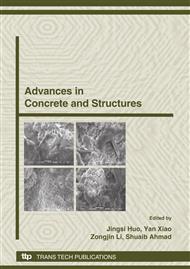p.385
p.391
p.395
p.403
p.409
p.415
p.421
p.427
p.433
Effect of Curing Conditions on Property of High Performance Concrete with Composite Mineral Admixture
Abstract:
In this paper, the development of cubic compressive strength of concrete with the age was studied first. Four kinds of concrete, which were made from the mixes by using 0%, 20%, 30% and 40% Composite Mineral Admixture (CMA) as the replacement of the cement for each kind of concrete, were used in the study. Test results showed that the concrete with 30% CMA had the best properties compared with others both under standard-curing condition and steam-curing condition. Furthermore, the normal concrete (without CMA ) and the high performance concrete (with 30% CMA) were chosen as the main materials in comparative tests to study the effect of curing conditions on the property of high performance concrete, such as the basic mechanical properties, the property against chloride penetration, and the property against carbonization. The results indicated that the curing temperature would increase the concrete strength in early age but not in long term. The curing condition would affect the property of concrete against carbonization but not the property of concrete against chloride penetration obviously.
Info:
Periodical:
Pages:
409-414
Citation:
Online since:
October 2008
Authors:
Price:
Сopyright:
© 2009 Trans Tech Publications Ltd. All Rights Reserved
Share:
Citation:


